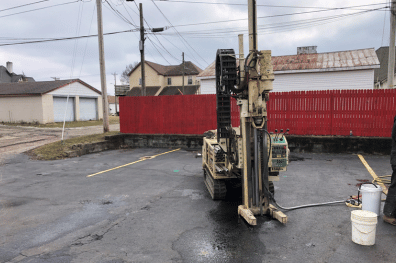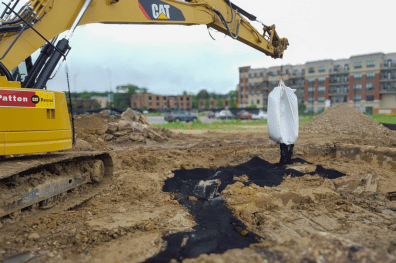ORIN successfully treated contaminated unsaturated soils using BAM treatment material in conjunction with chemical oxidation while simultaneously mixing soils with an excavator. Contaminant odor was detected throughout the project.
A grab soil sample was measured with a PID at 2,900ppm. Free product was also observed during the project. Approximately 1,400 cubic yards of soil were treated with Fenton’s Reagent. Following the completion of the Fenton’s reaction, approximately 8-10 cubic yards of BAM were applied to each batch of soil and thoroughly mixed with an excavator.
The Challenge
The site presented severe contamination indicators:
- PID readings of 2,900 ppm
- Visible free product
- Strong contaminant odors
- High TCLP TCE levels (10 mg/L)
- 1,400 cubic yards of impacted soil
- Need for non-hazardous classification
The Solution: Two-Phase Treatment
The team implemented a strategic treatment sequence:
- Primary Treatment Phase:
- Fenton’s Reagent application
- Complete reaction monitoring
- Excavator mixing integration
- Contamination breakdown initiation
- Secondary Treatment Phase:
- 8-10 cubic yards BAM per batch
- Thorough excavator mixing
- Even distribution verification
- Quality control monitoring
Implementation Strategy
Key operational elements included:
- Systematic batch processing
- Continuous mixing methodology
- Reaction completion verification
- Comprehensive sampling protocol
- Three-day stabilization period
Outstanding Results
The treatment achieved remarkable success:
- Initial TCLP TCE: 10 mg/L
- Final TCLP TCE: 0.1 mg/L
- Overall reduction: 99.99%
- Non-hazardous classification achieved
- Landfill disposal approval obtained
Key Success Factors
Several elements contributed to exceptional results:
- Strategic treatment sequencing
- Optimal chemistry combination
- Thorough mixing protocol
- Quality control measures
- Proper stabilization period
Innovation Highlights
The project demonstrated several advantages:
- Near-complete contaminant elimination
- Effective free product treatment
- Successful TCLP reduction
- Cost-effective disposal solution
- Rapid treatment success
Practical Applications
This success provides solutions for:
- Manufacturing site cleanup
- High-concentration TCE
- Free product presence
- TCLP compliance achievement
- Large volume treatment
This case study demonstrates how combining innovative technologies can achieve near-complete elimination of severe TCE contamination while enabling cost-effective disposal options.



